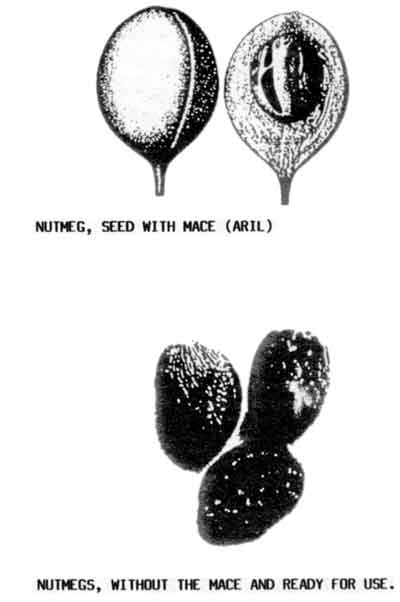
NUTMEG AND MACE
SCIENTIFIC NAME: Myristica fragrans
FAMILY: FAMILY: Myristicaceae
 The oriental spice trade is a very old one. Probably much older than the first known recorded mention of mace. In one of his works, the Latin writer/playwright Plautus, who lived in the second century B.C., made use of the word mace or 'macir' in Latin. Round the first century, merchant vessels brought spices from the coast of Malabar to Arabia and the African continent. The spices, from as far as the Moluccas (Indonesia), reached Rome overland by camel transport.
The oriental spice trade is a very old one. Probably much older than the first known recorded mention of mace. In one of his works, the Latin writer/playwright Plautus, who lived in the second century B.C., made use of the word mace or 'macir' in Latin. Round the first century, merchant vessels brought spices from the coast of Malabar to Arabia and the African continent. The spices, from as far as the Moluccas (Indonesia), reached Rome overland by camel transport.
The nutmeg comes from a large evergreen tree - Myristica fragrans. It is native to the Moluccas Islands.
Once the fleshy yellow fruit has ripened and dried, it splits open. Inside, enclosing the nutmeg seed, is the scarlet aril which is removed and dried to become mace or foelie.
The hard brown nuts are never used whole but are finely grated; freshly grated nutmeg is far superior to the powdered variety.
Where the name Mace originated from is not very clear. More appropriate names have been given by the Portugese, Malayans and Chinese. The metaphorical name of 'fula', which means 'flower' in Portugese, given the good resemblance of the red 'petals' which cling in stark contrast to the almost-black seed skin. In Malaysia and Indonesia the name for flower is 'bunga', and mace is called 'bunga pala'. The Chinese 'tou kou hua' is the literally translation of 'bunga pala' or 'flower of the nutmeg'.
The finer flavour of mace makes this spice much more expensive than nutmeg, although the flavour of the two is similar. Because it is rather expensive, ground mace is often adulterated, and like most spices, tends to lose its potency quickly.
Nutmeg is used extensively in Italy and the Middle East. As well as flavouring cakes and puddings, it is used with meat and vegetables - notably spinach, lamb and sausages, in sauces and with cheese.
Mace is used in a similar way too, in stews, sweet dishes, cakes and sauces, with fish, meats, particularly veal and chicken and vegetables. It is also good to use in a infusion to flavour cream, in poaching liquid, and in clear stocks, the appearance of which would be spoiled by grated nutmeg.
DATE: May 1993
* * * * * * * * * * * * *
